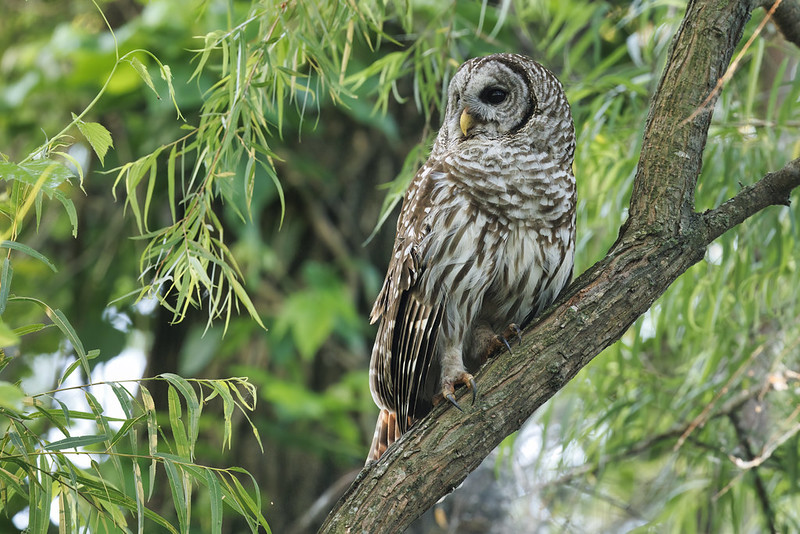I was driving slowly along the auto tour road at Sequoyah National Wildlife Refuge in Oklahoma when I came across a fascinating sight: a Barred Owl. Perched upon a storm-damaged tree, the owl had made itself comfortable amidst the remnants of the once towering trunk. The tree’s top had been lost to the forces of nature, leaving only the sturdy trunk behind. Curiously, a portion of the bark had draped over the exposed top, creating a cozy shelter for the owl.
Initially, I almost missed this marvelous creature, but my keen eye caught a glimpse of its presence. I swiftly parked my vehicle, ensuring I could capture the owl’s beauty through my lens. Just as I prepared to take the shot, the Barred Owl suddenly took flight and gracefully landed on a nearby tree. Although I wished I had captured it in its original location, I couldn’t help but feel grateful for the unexpected opportunity to witness the owl up close.


For some time, the Barred Owl perched on its new branch, allowing me to appreciate its intricate plumage and piercing eyes. As I observed, the owl’s attention was drawn to something across the road, prompting it to swiftly descend to the ground and disappear from sight. Although I missed documenting that particular moment, the memory of its presence and the wonder it evoked will forever remain with me.
Barred Owls, scientifically known as Strix varia, are remarkable birds native to North America. They are medium-sized owls with a wingspan of around 3-4 feet, making them a captivating sight in the wild. One of their distinguishing features is the barred pattern on their feathers, which gives them their name. These owls are adaptable and can be found in various forested habitats, from dense woodlands to swamps. They are particularly skilled at hunting small mammals, birds, and even amphibians, using their exceptional hearing and silent flight to their advantage.
In addition to their hunting prowess, Barred Owls are known for their distinct hooting calls. Their vocalizations, often described as “Who cooks for you? Who cooks for you all?”, can be heard during both day and night. These unique calls are a means of communication between individuals and serve to establish territories and attract mates.
Encounters with Barred Owls are treasured moments for wildlife enthusiasts and photographers alike. Their elusive nature and mysterious demeanor add to the allure of these magnificent creatures. Next time you find yourself exploring the great outdoors, keep an eye out for the Barred Owl, as you never know when you might have your own unforgettable encounter with this captivating species.
Gear Used:
- Camera: Canon EOS R5
- Lens: Canon RF 100-500 mm F4.5-7.1 L IS USM
Technical:
- Location: Sequoyah National Wildlife Refuge (Oklahoma)
- Date and Time Taken: May 18, 2023 (06:45 A. M.)
- Aperture: f8
- Shutter speed: 1/200
- ISO: 8000 (Auto)
- Exp. Comp.: +0.3
- Focal Length: 500 mm
